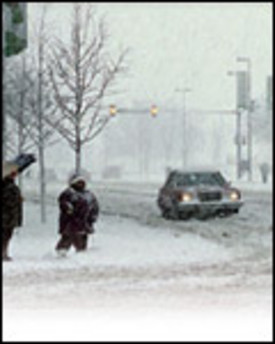 |
What Is a Winter Storm?
Winter storms derive their energy from the clash of two air masses of very different temperature and moisture levels. In North America, winter storms typically form when an air mass of cold, dry Canadian air moves south and interacts with a warm, moist air mass moving north from the Gulf of Mexico. Over North America, strong winds blowing from west to east usually move a winter storm quickly across the continent. That’s why a winter storm rarely lasts more than a day in one area.
One exception to this rule occurs downwind of major bodies of water like the Great Lakes. If a strong, cold wind blows over a great length of unfrozen water, the air can acquire a substantial amount of moisture. This moisture turns into heavy snow when it reaches land. These “lake-effect” snowstorms can last for many days and dump huge amounts of snow.
A lake-effect snowstorm in November 2000, dumped 25 inches of snow in 24 hours on Buffalo, NY. At its peak, snowfall rates of three inches per hour were reported.
The Dangers of Winter Storms
Heavy snowfall and extreme cold can immobilize an entire region. Even areas that normally experience mild winters can be hit with a major snowstorm or extreme cold. The impacts include flooding, storm surge, closed highways, blocked roads, downed power lines, and hypothermia.
You can protect yourself and your home from the many hazards of winter by planning ahead.
Learn These Important Cold Weather Terms
Understand these terms used by forecasters concerning winter weather:
- Freezing Rain – Rain that freezes when it hits the ground, creating a coating of ice on roads, walkways, trees, and power lines.
- Sleet – Rain that freezes when it hits the ground, creating a coating of ice on roads, walkways, trees, and power lines.
- Winter Storm Watch – A winter storm is possible in your area.
- Winter Storm Warning – A winter storm is occurring, or will soon occur in your area.
- Blizzard Warning – Sustained winds or frequent gusts to 35 miles-per-hour or greater and considerable falling or blowing snow (reducing visibility to less than a quarter mile) are expected to prevail for a period of three hours or longer.
- Frost/Freeze Warning – Below freezing temperatures are expected.




























